EPCAMR was contracted by the Earth Conservancy to monitor the Espy Run AMD Treatment System after rehabilitation and improvements were made in 2011 to allow additional iron to drop out by increasing the size of the polishing ponds in the aerobic wetlands system. EPCAMR assisted the Earth Conservancy in securing free technical assistance for design and engineering of the system through a PA Association of Conservation Districts, Inc. Technical Assistance Grant (PACD TAG), designed by John Coleman, who was an Engineer, contracted by PACD, who worked for the Natural Resources Conservation Service (NRCS), Bloomsburg Office. From Summer 2012-Summer 2013, EPCAMR completed 4 services in order to assess and predict the long term performance and ongoing treatment of the AMD wetlands treatment system.
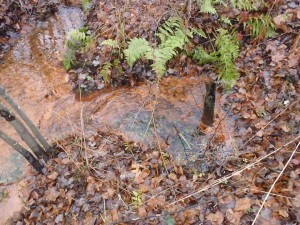
The source of the AMD discharge feeding in to the Espy Run is located near the tree branch sticking out of the water on the right side of the photo.
EPCAMR completed AMD water quality and water flow monitoring of the Espy Run AMD Treatment System from August 2012-August 2013 in order to determine loading of iron, alkalinity, pH, acidity, and temperature at the Espy Run influent sites (old wetland, new channel, new pipe), 3 points within the treatment system (Pond A, Pond B, Wetland), the Espy Run effluent, and downstream of the Espy Run combined AMD Treatment Systems. After completing the year long testing period, EPCAMR completed a final report detailing all of the data gathered on water flow and water quality. EPCAMR’s work on this project, in collaboration with the Earth Conservancy allows them access to this area for educational outreach programs with local school districts in order to provide insight into AMD treatment systems, how to improve water quality through different water treatment technologies, and incorporate PA’s Department of Education’s Environment and Ecology Environmental Education Standards that compliment the various schools existing curriculum.
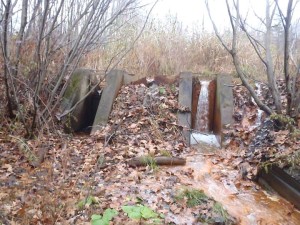
Weir #3 and Weir #4 on the outlet side of Espy Run before rehabilitation. As can be seen by the lack of flow and build-up of leaf debris, some maintenance was needed to get both weirs fully functioning again.
In 2011, after the Espy Run was rehabilitated, the average flow from the system was 521 gpm. With this flow, the system was able to remove 303 pounds per day of acidity while retaining 91.7 pounds of iron per day and thereby removing it from the stream. During the 2012 monitoring period, EPCAMR found that the average rate of flow from the system was 215 gpm, allowing the system to remove 162 pounds per day of acidity while retaining 18.8 pounds of iron per day.
These numbers show a dramatic contrast between the 2011 assessment period and the 2012 assessment period. While these differences seem to point to a lack of effectiveness within the system, a number of factors led to these findings. 2011 was a year with above average precipitation while 2012 was a dry year with lower than average rainfall. The dramatic differences in rainfall greatly influenced the amount of flow within the system. In addition, treatment systems like the Espy Run system generally experience a “Honeymoon Period” in which the system performs better than expected. Treatment efficiency is related directly to flow and the eventual loadings of the iron, alkalinity, and acidity of the mine water.
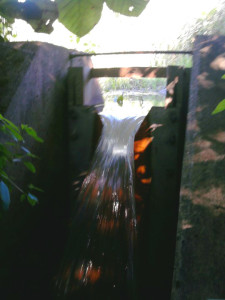
V-notch weir post-construction spilling out cleaner water! The iron has been reduced by 90%, the pH and dissolved oxygen have been increased, as a slight increase in water temperature.
In order to help improve water residency time within the system, reduce short-circuiting of the mine water, and optimize iron loading retention, the Earth Conservancy, through funding from a Quick Response Grant administered by our sister Coalition, the Western PA Coalition for Abandoned Mine Reclamation (WPCAMR), applied further modifications to the system. One of these modifications included sandbagging the inlet half-pipe channel to direct water into Pond B only. The outlet from Pond B was sandbagged, with Ponds A & B connected by a pipe allowing for flow from one to the other, leaving both ponds with a common outlet channel. In addition, a bridge was constructed over the outlet channel so that access to the old wetland system would be easier.
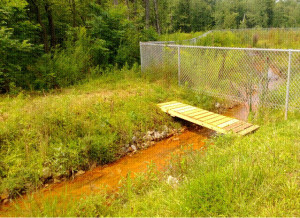
The bridge, shown going over the water in the rehabilitated Espy Run treatment system. The water, coming out of Ponds A & B in the system, is much clearer with a reduced orange color, indicating lower iron levels and cleaner water.
In order to redirect short-circuiting water issues a concrete Jersey Barrier was installed at the inlet to the old wetland system. Lastly, the weirs were lowered on the outlet of the old wetlands to lower water levels so that wetland vegetation had more surface area to grow. Cattails, phragmites, and several other wetland species of plants normally do not grow well in water at a depth of 18″ or greater. These modification proved to be successful, allowing for an additional 6 pounds per day of iron and neutralization of an additional 22 pounds per day of acidity. After gathering data on chemistry and flow, EPCAMR determined that optimal treatment levels are reached between 150-300 gpm. Flows lower than 150 gpm were not recorded during the assessment period, but if these low flow levels were to occur, they could cause detrimental chemical reactions in addition to allowing for excessive plant growth. On the other hand, if flows reach above 300 gpm, they can cause damage to the system. EPCAMR did not record flows at this level, but observation of damaged berms within the system indicated that water flow had been extremely high at some points during the assessment period.
During the assessment period, EPCAMR made some additional observations that allowed for a better understanding of the effectiveness of the treatment system. Weather conditions had a significant impact on results. The greater precipitation, the more water trapped in the minepool, thus the greater the flow of AMD discharge into the treatment system. Higher flow, as mentioned above, can cause potentially cause damage to the system. EPCAMR observed that lowering the weirs in order to restrict water levels allows for mediation of this problem. In addition, warm weather conditions appear to create downstream “thermal pollution” on the cold water pouring out of the discharge, raising the temperature in ponds and wetlands 20 degrees fahrenheit or more. While this is an issue often associated with wetland type passive treatment systems, the beneficial removal of acid and heavy metal deposits is a worthwhile trade-off. On the other hand, cold weather conditions tend to slow down chemical reactions, hindering the removal of iron and neutralization of acids. During some of the winter sampling periods, Pond A suffered from periodic freezing due to the half-pipe’s “uneven” distribution. Modification of the system helped to remedy this issue.

Panoramic view of Pond B (left) & Pond A (right) showing the flow through pipe. Notice the brighter orange color of Pond B, indicating that more iron is settling out.
Although biological sampling and visual habitat were not a part of their services, EPCAMR noted evidence affirming that wildlife is inhabiting the treatment system. Frogs were croaking and jumping as EPCAMR staff walked across the berms, and tadpoles were seen in the spring to early summer along the outlet channels. Turtles were seen sunning themselves on the banks. Redwing Blackbirds and other bird species co-habitated throughout the area. A mother goose built her nest among the thick wetland plants and was often seen chasing EPCAMR staff around the wetlands a they gathered water samples.
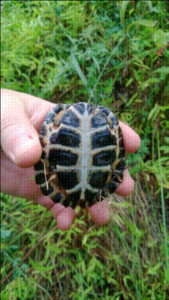
This baby Wood Turtle was seen sunning himself on the banks of the treatment system. His orange color is not from iron oxide, but shows his natural coloring. This little guy is a good sign!
Deer and turkeys were often seen roaming the fields above the ponds and wetlands. Pond A was teeming with schools of minnows. Beavers and muskrats were trapped out of the system so that they could not cause damage, but the beaver dam located near the USGS gauging station redirected the water over the weir, allowing for the system to work as it was originally intended to flow.

Taken downstream near the USGS gas station, this photo shows the beaver dam. This dam actually redirects the majority of flow back over the wier, The water here is cloudy, but the orange color is mostly gone, indicating that there is less iron in the stream.
EPCAMR’s year long assessment period showed that the Espy Run AMD Treatment Facility was largely successful at treating iron oxide deposits located in the stream. As of August 2013, the last assessment month for EPCAMR, the iron concentration coming into the treatment system was 10 Mg/L. As shown in the below left graph, after treatment, the iron concentration coming out of the system was approximately 32 Mg/L. As shown in the below right graph, as of August 2013, the iron load held within the system was approximately 22 lbs/day when the flow was around 225 gal/min. These figures show that after modification, the system was able to treat water at higher flows than was previously recorded.
While recorded data shows that they system was effective at treating iron oxide deposits and acidity within the water, visual assessment made it clear to any observer that the treatment system was helpful in reducing pollution within the water. The water leaving the treatment system was still cloudy, but lacked the bright orange pigment, indicating that the system was effective at removing a lot of acidity and iron oxide. Other indicators, such as visual observation of wildlife show that the wetland is able to be inhabited rather than remaining a biological deadzone as it had been prior to treatment. An increased number of fish species were found to be present downstream of the treatment system such as smallmouth bass, creek chubs, black-nose dace, blue-gills, and shiners. EPCAMR will be continuing to monitor the system for the Earth Conservancy on a quarterly basis through the Fall of 2014.






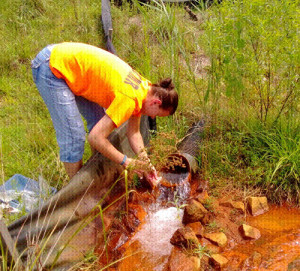
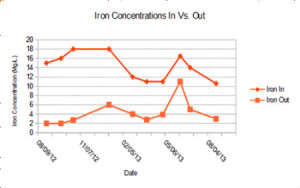
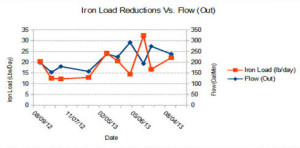






You must be logged in to post a comment.